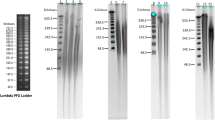Abstract
Extraction of high-quality genomic DNA fromGossypium (cotton) species is difficult due to high levels of polysaccharide, oxidizable quinones, and other interfering substances. We describe a procedure that consistently permits isolation of cotton genomic DNA of satisfactory size and quality for RFLP and PCR analysis, as well as for most routine cloning applications. Several antioxidants, phenol-binding reagents, and phenol oxidase inhibitors are used throughout the procedure, and most polysaccharides are eliminated early in the procedure by isolation of nuclei.
Similar content being viewed by others
Abbreviations
- CIA:
-
chloroform-isoamyl alcohol
- CTAB:
-
hexadecyltrimethyl-ammonium bromide
- DIECA:
-
diethyldithiocarbamic acid
- RAPD:
-
random amplified polymorphic DNA
References
Bernatzky, R. B., and S. D. Tanksley. 1986. Toward a saturated linkage map in tomato based on isozymes and cDNA clones. Genetics 112:887–898.
Couch, J. A., and P. Fritz. 1990. Extraction of DNA from plants high in polyphenolics. Plant Mol. Biol. Reptr. 8 (1):8–12.
Fryxell, P. A. A revised taxonomic interpretation of Gossypium. RHEEDIA, in press.
Murray, M., and W. F. Thompson. 1980. Rapid isolation of high molecular weight plant DNA. Nucl. Acids Res. 8:4321–4325.
Katterman, F. R. H., and V. I. Shattuck. 1983. An effective method of DNA isolation from the mature leaves ofGossypium species that contain large amounts of phenolic terpenoids and tannins. Prep. Biochem. 13(4):347–359.
Loomis, W. D. 1974. Overcoming problems of phenolics and quinones in the isolation of plant enzymes and organelles. Meth. Enzymol. 31:528–545.
Sambrook, J., E. F. Fritsch, and T. Maniatis. 1989.Molecular Cloning: A Laboratory Manual, 2nd ed., Cold Spring Harbor Press, Cold Spring Harbor, NY.
Wendel, J. F. 1989. New-world tetraploid cottons contain Old World cytoplasm. Proc. Natl. Acad. Sci. USA 86:4132–4136.
Williams, J. G. K., A. R. Kubelik, K. J. Livak, J. A. Rafalski, and S. V. Tingey. 1990. Oligonucleotide primers of arbitrary sequence amplify DNA polymorphisms which are useful as genetic markers. Nucl. Acids Res. 18:6531–6535.
Author information
Authors and Affiliations
Rights and permissions
About this article
Cite this article
Paterson, A.H., Brubaker, C.L. & Wendel, J.F. A rapid method for extraction of cotton (Gossypium spp.) genomic DNA suitable for RFLP or PCR analysis. Plant Mol Biol Rep 11, 122–127 (1993). https://doi.org/10.1007/BF02670470
Issue Date:
DOI: https://doi.org/10.1007/BF02670470




